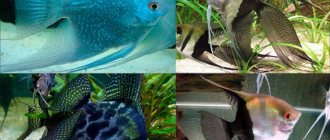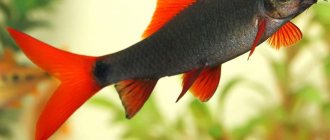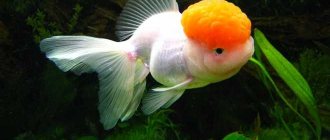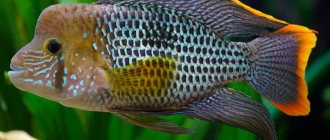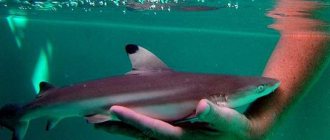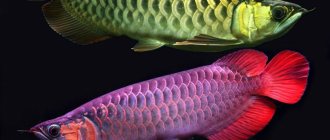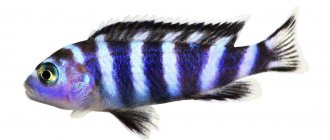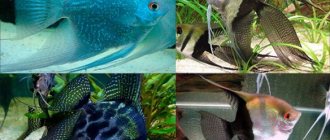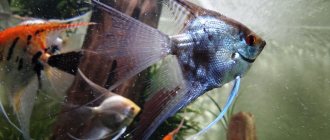Description
The name “ternation” is not the only one, because the fish is also called the black tetra. This is due to the external color - the body is silver, with two black transverse stripes and a darkened area at the caudal fin. There is also a characteristic black skirt - an elongated anal fin. There is also a wen on the back, as a sign of the Heracinaceae family.
In nature, thornetia lives in South American rivers with weak currents, in areas of strong vegetation and shade. The environment in such reservoirs is usually acidic and soft. The fish swim near the surface and eat flies and mosquitoes that fall into the water. They are the basis of their diet.
The size of the thorn is small - the thorn fish reaches 5 cm. They live in aquarium conditions for up to 6 years.
The main differences between a female and a male are as follows: females are slightly larger than males, but they have a longer dorsal fin.
Males differ from females in their smaller size and high, pointed fin.
Description and characteristics
The aquarium fish Common Thorn belongs to the order Characinidae, and in the wild it lives in the reservoirs of Paraguay, Brazil, and Argentina. A distinctive feature of the aquarium thorn is considered to be the fish’s extraordinary mobility at home, as well as its friendly character, thanks to which the phenotype easily gets along with other fish. The color of the thorn is considered a peculiarity of its appearance - the pets have two dark stripes across the body, but some varieties have no stripes. In captivity, the phenotype grows up to 6 cm in length, with an average lifespan of four years.
Description of the thorn fish:
- flat body, elongated and flattened at the sides;
- wide anal fin;
- the lower jaw protrudes forward.
Among the different varieties of the species, the most popular are caramel thorn and glofish.
Maintenance and care in the aquarium
Ternetia is a pack animal. One aquarium can contain 8-10 individuals. It is not recommended to plant fish one at a time, otherwise they will be hostile to the rest of the inhabitants. For a small flock you will need an aquarium with a total capacity of 60 liters or more. Ternetias are prone to jumping out of the water, so it is better to get a lid.
Suitable soil would be sand of any fraction, small pebbles or gravel. Driftwood, clay houses, tall and dense thickets of plants are suitable as decorative elements.
Fish do not like intense lighting. It is recommended to install weak diffused light, which will be partially covered by tall, broad-leaved plants.
Ternetia loves clean water, with a normal content of nitrates and phosphates. To provide good conditions for the fish, you will have to acquire a filter and a compressor for aerating the water. In order to create the effect of “dark water”, as in natural conditions, you can add a special tinting conditioner from the Tetra company to the aquarium.
To maintain a bright and colorful body color for species such as caramel and glofish, there are foods with natural color enhancers.
As for the remaining parameters, you must comply with:
- Temperature within 22-26 degrees Celsius;
- Hardness no more than 20 dGH;
- Acidity from 6 to 7.5 pH.
As mentioned above, in the natural environment, fish feed on insects and various larvae. To provide a complete diet in aquarium conditions, you will have to acquire high-protein food.
There are many quality fortified flakes or small granules available. They stay on the surface longer, making it easy for fish to eat them.
Also, to maintain a bright and colorful body color for species such as caramel and glofish, there are foods with natural color enhancers.
In addition, thorns perfectly eat live and frozen food - daphnia, bloodworms. From time to time you can throw chopped spinach or zucchini to the fish. A complete, balanced diet is the basis for strong immunity and a healthy appearance.
Caramel thorn nutrition
Although the caramel thorn does not complain of appetite, there are no problems with feeding it. Fish of this species are omnivores. Therefore, both dry and live food, as well as all kinds of substitutes, are suitable for them.
Ternetia's favorite delicacy is live or frozen food, such as bloodworms, daphnia and brine shrimp. The fish eat food from the middle layer of water to the very bottom. Even fallen food will not go unnoticed.
Like all aquarium fish, caramel needs a varied diet. Don't focus entirely on one type of nutrition and forget about all the others. The Ternetia menu should include both live and dry food. They need both proteins and plant foods.
In specialized stores you can find food intended for certain types of fish. They contain the microelements that certain fish need.
For example, there is special food for fry. It is good if newborn ternets consume it, as it is saturated with all the minerals and vitamins necessary for the development of the fry.
Compatibility with other fish
As a rule, thorns are quiet and calm fish. However, sometimes they can become aggressive towards their neighbors. This usually happens if there are few thorns in the general aquarium. If the school is large, then the fish do not pay attention to the others and are only occupied with their own appearance.
You should not add veiled fish with long fins to them, otherwise small robbers may bite them. Fish that are too small or too large will also not be suitable. The best option is catfish, tetras, swordtails, gourami, zebrafish, etc. They are similar in size and behavior.
As a rule, thorns are quiet and calm fish. However, sometimes they can become aggressive towards their neighbors.
Diseases
Almost any disease of aquarium fish is associated with insufficient care and poor maintenance. If high-quality conditions are created, quarantine is observed for new individuals, plants or soil, and live food is processed, then the risk of parasites or fungi developing in the container is minimized.
In addition, thorns have strong immunity. With good quality food and clean water, they are not susceptible to disease. However, if the environment has changed, the thorns react sharply to this. Their behavior changes, their color fades.
When the lighting is too bright and the water is too acidic, the fish develop alkaline disease, and when the acidity decreases, the fish develop acid disease. If the filter power is not enough to reduce the concentration of ammonia in the water, pets may experience acedaemia. Under densely populated conditions, fish of any breed develop hypoxia.
If you pour poorly settled water when changing water, your pets may experience chlorosis.
Feeding thorns with low-quality or monotonous food can lead to gastrointestinal problems or obesity.
Against the background of general exhaustion and deterioration of immunity, fish may be susceptible to parasitic infection and the occurrence of ichthyophthyriasis, fin rot, etc.
Breeding
Thorns do not have problems with breeding, so even a beginner can get offspring after reading the rules and requirements.
Interesting video: How to understand when to place fish for spawning?
To begin with, a suitable pair is selected. A week before the expected spawning, the fish are placed in separate containers and fed generously with high-protein food. Also at this time you need to prepare the spawning tank. For this, take a container of 35-40 liters. Plants with small leaves are placed at the bottom, which will become a natural obstacle for fish so that they cannot eat the eggs. Parameters for the spawner:
- Temperature from +24 to +26 degrees;
- Hardness about 4 dGH;
- Acidity 7 pH.
First, the male is placed in the container. When he settles in, after a few hours you can transplant the female. The aquarium is then completely shaded and left until the morning.
The beginning of spawning is the bright rising sun early in the morning (or artificial light). The female begins to spawn. During the entire process, one aquarium fish can lay up to 1000 eggs. After they are fertilized, the breeders are placed back in the community aquarium.
Within 24 hours, the eggs hatch into fry. When the yolk sac supplies run out, they begin to feed on their own. This usually happens on the third day. Live dust, ciliates and artificial food for babies are perfect as initial food.
At the age of 6-7 months, the fish reach sexual maturity. Reproductive function lasts up to two years.
Kinds
Today there are four known varieties of ternation:
Ordinary
The thorn fish has an olive green color with two transverse dark stripes. The fins and tail area are darkened, the eyes are orange.
Ternetia veil
It was developed through selection. This species is distinguished by elongated fins, which resemble a veil when the fish moves. They are unpretentious in content. The only thing to remember is to avoid aggressive neighbors who can bite the fins, and avoid sharp edges of the ground;
Albino
This morph is special in that the fish completely loses its coloring pigment. The result is a white, beige or slightly pinkish coloration and red eyes. Albinos do not require special care, so the conditions for them are the same as for ordinary thorns;
Ternetsia caramel
A form that is artificially painted in bright colors. However, these manipulations worsen the immunity and health of the fish, so it is necessary to monitor the cleanliness of the water. As a rule, albino forms of fish are subject to painting; against their background, the paint looks very colorful, but as the fish grows older, the color of the fish becomes paler;
Reproduction of thorns at home
I have already bred thorns before and I will say that there are no difficulties in removing them. But then twenty years ago there were no genetically modified fish, so I decided to try to breed pink and red GloFish and share with you my observations if differences were found in breeding natural and modified fish.
Note: GloFish is a group of genetically modified aquarium fish that are capable of fluorescing, that is, glowing, in blue lamp light or ultraviolet radiation. The keeping conditions are completely similar to natural species, but the bright, rich color makes these fish very popular among aquarists.
